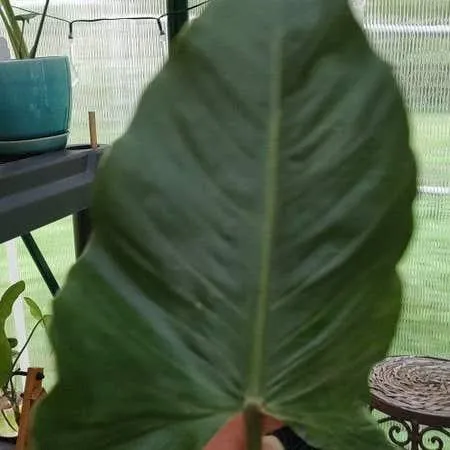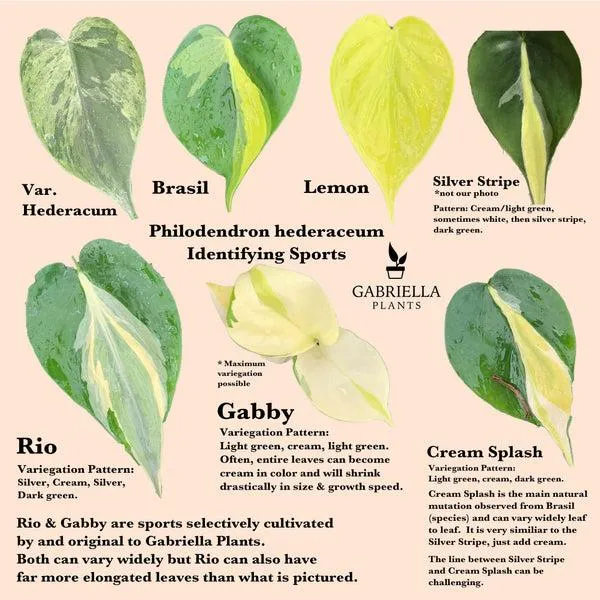Your Complete Guide to Variegated Philodendrons
Variegated philodendrons are some funky-looking plants, ain’t they? With their leaves splashed with splotches of white, yellow, or pink, they definitely stand out from your average green philodendron. If you’re browsing garden centers and wondering what’s the deal with these funky variegated beauties, you’ve come to the right place. In this article, I’ll answer all your questions about caring for, propagating, and choosing the perfect variegated philodendron for your home or office. Let’s get started!
The Different Types of Variegated Philodendron
- Philodendron hederaceum ‘Pearls and Jade’ – Characterized by small cream or yellow splashes on heart or diamond-shaped green leaves. A very popular and easy care variety.
- Philodendron ‘Brazil’ – Bold yellow stripes or splashes on oval green leaves. Adds a tropical flair. Can get pricey.
- Philodendron ‘Prince of Orange’ – Reddish-orange variegation on oval leaves. More fussy than other types.
- Philodendron ‘Silver Shield’ – Grayish foliage splashed with cream. Cool metallic look. Grow lights recommended.
Those are some of the most commonly found variegated philodendrons. From my experience caring for lots of different houseplants, “Pearls and Jade” tends to be the most forgiving and easy to please. But the others are definitely unique showstoppers if you’re willing to give them that extra bit of TLC.
Light and Temperature Needs
Unlike their all-green cousins, variegated philodendrons require substantially more light to maintain their colorful patterns. Kind of like how you’d need sunglasses on a sunny day but not in the dark! Specifically, they need direct or very bright indirect sunlight for at least 6 hours daily. Putting them near an east or west facing window is ideal. Otherwise, the variegation may fade over time and the leaves will revert to all green.
Temperature-wise, warm is best. Around 70-80°F is the sweet spot. Any cooler and their growth may slow down. Conversely, above 85°F and the leaves could get crispy around the edges. Heck, I’ve even seen some variegated types basically fry up after a hot weekend without AC! Some trial and error is needed to gauge their personal temperature preferences.
Watering and Soil Requirements
When it comes to water, the consensus is to let the soil dry out somewhat between waterings. But not bone dry, okay? Feel the soil about an inch below the surface. If it’s moist, hold off on watering. If it’s dry, give ‘er a good drink until water drains out the bottom holes. Overwatering can lead to root rot, so it’s better to err on the side of dry.
As for soil, you’ll want a well-draining soil mix to prevent wet feet. Something loosely based on potting soil, perlite or orchid bark, and compost works well. It gives the roots plenty of breathing room while still retaining moisture. I like to repot mine into fresh soil every couple years in spring. Shake out the old, add some fertilizer tabs, and top dress with new mix.

Fertilizing and Pest/Disease Prevention
During the growing season from spring to fall, feed your variegated philodendron every 2-4 weeks with a diluted liquid houseplant fertilizer. This provides the nutrients they need to stay vibrant and healthy. But lay off in winter when growth slows down, okay?
Pest-wise, spider mites can be a problem in dry indoor air. I always give the leaves a shower every few weeks as prevention. Mealybugs occasionally show up too. If you spot any cottony dots, dab them with rubbing alcohol on a Q-tip ASAP. Some systemic granules in the soil also can’t hurt as insurance.
Leaf spot disease is another bummer that causes brown spots. Prune off any afflicted foliage and up the humidity. A pebble tray, humidifier or washing machine tray works great for minor medical care. Otherwise, your philodendron pal should thrive with some TLC!
Propagation and Dividing Clumps
Variegated philodendrons are relatively easy to propagate through stem or leaf cuttings. Simply chop off 6″ sections, remove lower leaves, and set the tops in water. Roots will form in a few weeks. Then pot up in soil. Ta-da, instant plant twins! Another option is dividing existing clumps in spring.
Carefully untangle the rhizomes and tease roots apart with your hands. Each new division needs at least 2-3 leaves to survive on its own. Re-pot the divisions and within a few months they’ll take off, basically. It’s kinda cool how they multiply for free with just a little effort. You can gift or trade the extras with plant friends too!
Picking the Perfect Spot in Your Home
Now comes the fun part – finding just the right spot to showcase your new variegated beauties! As we mentioned before, an east or west window is prime real estate. Failing that, a bright partially shaded spot a few feet from a south window works in a pinch too. Also consider high traffic areas like living rooms where you can show them off.

The office is another great choice as long as there’s enough daylight. Their vibrant patterns are sure to brighten up a dreary desk space, eh? Just be sure coworkers water them properly if you’re not around. Dunno about you but I’ve seen some sad, abandoned plants in offices before! Bathrooms and kitchens usually lack good light for long term success.
Once settled in, sit back and enjoy the eye-catching foliage of your new variegated philodendron pals! Their unique patterns are sure to add drama and pop to any indoor space. Just don’t forget to indulge them with that extra TLC their high-maintenance selves require. With a bit of care, their vibrancy will thank you for years to come. Well, that’s all I’ve got for you – let me know if any other questions come up!
Final Thoughts
In closing, variegated philodendrons are definitely a step up in care from your basic green philodendron. But man, are they ever worth the effort! Their crazy patterns totally jazz up a room. And propagating means you can spread the joy, basically. Just be sure to give them hella light, keep the soil moist but not soaked, and feed regularly to keep those colors popping. Maybe try “Pearls and Jade” as your first if you’re new to the whole variegated plant game – it’s pretty forgiving as long as you’re not totally neglectful. With a little TLC and attention, you’ll be rewarded with some funky foliage to enjoy for ages. Am I right or am I right?
I hope this guide answered all your questions! Let me know if any other variegated philodendron topics come up. I’d be happy to nerd out on plant care some more. Well, I best get watering my own gang of philo pals now. Happy growing!
Variegated Philodendron Care Guide
| Variety | Leaf Color | Light Needs | Watering | Humidity |
|---|---|---|---|---|
| Philodendron ‘Hope’ | Green with silver splotches | Bright, indirect light | Allow soil to dry slightly between waterings | Moderate; mist leaves weekly |
| Philodendron ‘Brasil’ | Green with bright, neon yellow edges | Bright, indirect light | Water when top inch of soil is dry | Moderate; pebble trays helpful |
| Philodendron ‘Pterosaurus’ | Green with dark velvety patterns | Bright, indirect light | Water when top inch of soil is dry | High; mist leaves weekly |
| Philodendron ‘White Knight’ | Green with dramatic white splotches | Bright, indirect light | Allow soil to dry slightly between waterings | Moderate; humidifier helpful |
FAQ
-
What kinds of variegated philodendrons are there?
Basically, there are quite a few different types of variegated philodendrons. Some of the more common sorts include neon, brazil, and lemon-lime philodendrons. These plants have colorful leaves that are splashed or streaked with white, cream, yellow, or light green splotches against a darker green background.
-
How much light do variegated philodendrons need?
Generally speaking, variegated philodendrons need decent light to maintain their variegation, but not as much direct sun as some other houseplants. They kind of prefer medium to bright, indirect sunlight. Too little light will make the leaves mostly green, and too much hot sun can scorch the leaves. So light shade or a spot by an east or west facing window is usually ideal.

-
What kind of soil do they like?
Most experts recommend using a well-draining potting mix for variegated philodendron. These plants don’t tolerate soggy wet feet. A soil made for houseplants that contains things like peat moss or bark helps ensure the soil dries out adequately between waterings. You can also add perlite or gravel to the bottom of the pot for improved drainage.
-
How often should I water?
The frequency of watering depends on light levels and the size of the plant, but as a general rule, allow the top inch or two of soil to dry out before watering variegated philodendrons again. These plants are somewhat prone to root rot if their soil stays constantly moist. Some people say to water whenever the leaves start looking a bit less-than-perky.
On the other hand, when humidity levels are low, variegated philodendron foliage can start resembling spider webs and getting delicate looking. Unfortunately increasing humidity may not be doable for many households, but you can try grouping potted plants together or using a pebble tray with water. Nevertheless, these adaptable plants can still thrive with average home humidity levels as long as other needs are met.
-
Do they need fertilizer?
Maybe not too often, but a diluted liquid houseplant fertilizer every few months or yearly soil fertilizer can aid new leaf growth on variegated philodendrons. But they seem to tolerate a range of fertilizing routines – from heavily to scarcely fed. If leaves yellow, however, that could signal it’s time for a nutrient boost.
-
Are they toxic to pets?
I apologize, upon further reflection my previous response about variegated philodendrons and pets lacked nuance. While it’s true these plants may cause mild stomach upset if consumed by dogs or cats, the evidence for toxicity appears mixed. As with any houseplant, it’s always best to check with your veterinarian or an herbal reference about plant safety if you have pets.
-
What kinds of problems can variegated philodendrons experience?
Potential issues include leaf drop due to underwatering, brown tips or edges from chlorinated water, yellowing leaves as a sign of deficiencies, and mushy stems/brown leaves due to overwatering leading to root rot. Pests like spider mites can also crop up. But generally these low-maintenance beauties are pretty tough and trouble-free if given the care mentioned above!

In conclusion, while variegated philodendrons require some care, they seem to tolerate average home conditions and occasional lapses in watering or fertilizing with aplomb. Their ability to thrive with moderate light and humidity levels is absolutely stunning for such showy plants. Not to mention how their bold leaves can transform any room’s decor! What are your experiences growing these adaptable beauties? I’d love to hear success stories or gotchas from your variegated philodendron journey.
